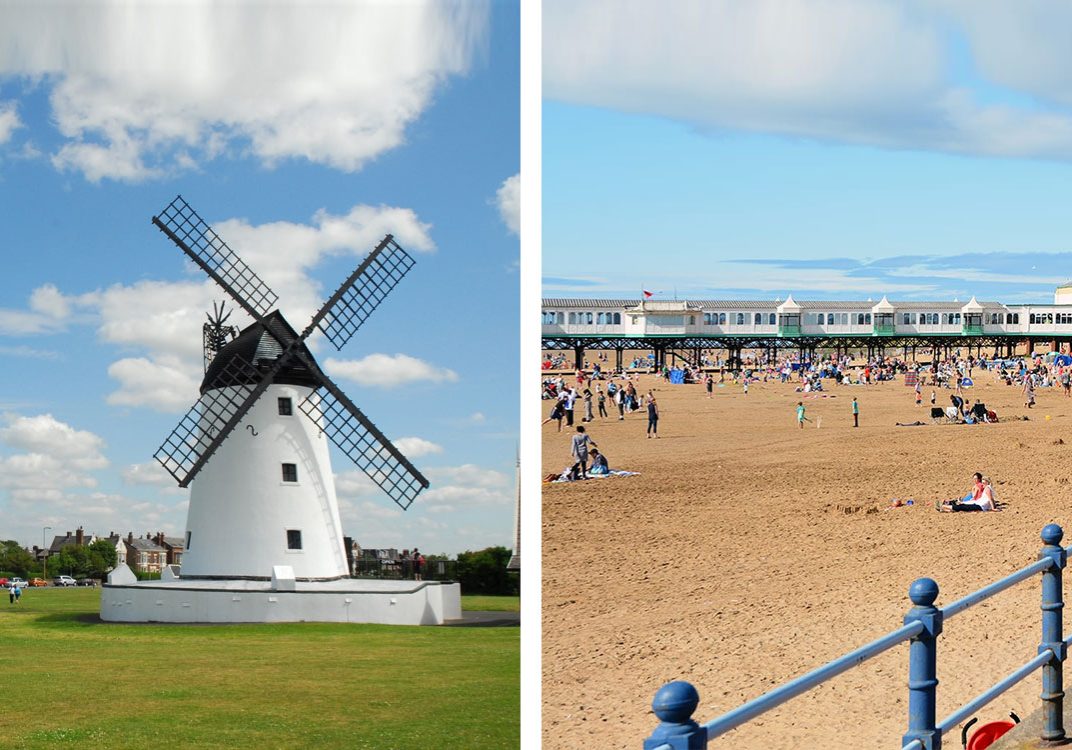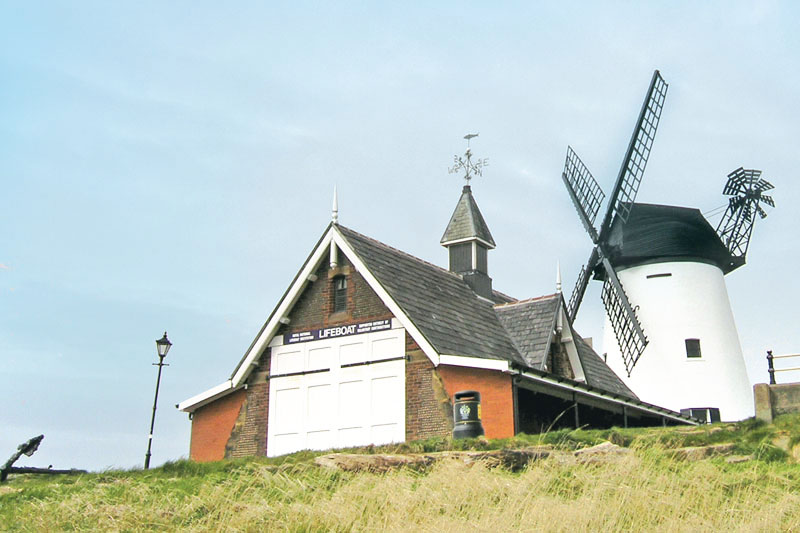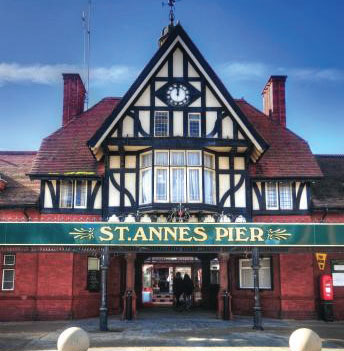
A Tale Of Two Towns
by Susannah George
St Annes retains much of its original character today and shouldn’t be compared to its neighbour town of Lytham as each has its own qualities and charm.
“Go on then.” I didn’t need much persuading after my lovely mum suggested we go to Lytham and take a picnic. Just a few miles from Blackpool Tower and the fun of the Pleasure Beach, Lytham and St Annes are very different in both appeal and atmosphere. The dual seaside towns are situated along a picturesque stretch of coastline and one of the highlight landmarks for me is the Windmill on the Green at Lytham. Richard Cookson sought and obtained a lease from the Squire for a plot to build a ‘windy milne’ in 1805. However, when the area became more developed with prestigious properties not all the residents were happy with the Windmill and deemed it a nuisance. In 1919 a terrible gale caused severe damage and the Windmill was ravaged by fire and entirely gutted. It remained a shell of its form self until 1921 at which time it was given by the Squire to Lytham District Council. In 1989, the Windmill was restored by Fylde Borough Council and opened to the public and is run in partnership with Fylde Borough Council and Lytham Heritage Group.

There is also the Lifeboat Museum which details the Great Lifeboat Disaster of 1886. 27 lifeboat men from the St Annes and Southport crews lost their lives, trying to rescue 12 men from the shipwrecked sailing vessel The Mexico. The barque was repaired only to be lost in Scottish waters in 1890.
Up until the disbanding of the Monasteries Lytham had an established Priory. Following the dissolution, which began in the 1530s the land occupied by Lytham Priory came into the possession of local landowner Cuthbert Clifton who built a house there in the 17th Century. This house was replaced by Lytham Hall, built between 1757–1764. The Clifton family were a positive influence on Lytham, this ranged from their buildings and donated land and gifts to the town. The last 100 years of their time at Lytham Hall coincided with the beginning of the Victorian age, which was a time of great opulence for Lytham.

The description ‘seaside watering place’ for holiday resorts became popular by the end of the 18th Century and encouraged the building of hotels, houses and shops. As I write holiday resorts it pokes at my beef about how holidays in our beautiful country are being called ‘staycations’ A staycation is a period in which an individual or family stays home and participates in leisure activities within day trip distance of their home and does not require overnight accommodation. I appreciate that COVID 19 has stopped people travelling abroad but why should families that never went abroad now come under the bracket of having a ‘staycation’ It was never called that before so why label UK holidays now as staycations? Anyway I will climb off my high horse and continue!
On the day of our visit, given the beautiful weather and general popularity of the area, we took a little while to park but the moment my toes touched the warm golden sand of St Annes it was worth the wait. On the fringe of the beach are an array of attractive beach huts painted in pastel tones and look every inch the vision of a seaside tradition. Beach huts have a long history in St Annes and they have been around on the Fylde coast for hundreds of years. The last beach huts in St Annes were demolished in the late 1980s, however the St Annes Beach Hut Team have worked hard since 2010 to bring the beach huts back to St Annes.
St Annes was a 19th Century planned town and was formally established on 31 March 1875 when the foundation of the St Anne’s Hotel was laid. The town was developed from 1875 after Thomas Fair, agent to the Clifton Estate, sold leases to the St Annes on the Sea Land and Building Company. Maxwell and Tuke, an architect firm from Bury, laid out their plans for the town. Another one of their notable commissions was the design of Blackpool Tower.

St Annes retains much of its original character today and shouldn’t be compared to its neighbour town of Lytham as each has its own qualities and charm. Sand dunes fringe the beach and the town has a sand dune nature reserve. The dunes of St Annes are well known and they stretch from St Annes pier to the boundary of Blackpool South Shore against the tram depot at Squires Gate. They’re an important natural sea defence and a rich wildlife habitat.
I must mention the Victorian Pier at St Annes and the unique design. It is a mix of a Tudor style entrance that was built in 1899 with additions in the early 20th Century which included a Moorish-style pavilion and Floral Hall in 1910. I don’t want to insult any readers but in case you didn’t know and I didn’t, Moorish is a style within Islamic architecture. The pier was designed by Alfred Dowson and completed in 1885 and was one of the earliest public buildings in St Annes.
The English Heritage recognised how essential the Pier was when they designated it a Grade II listed building on 21 September 1973. It was in 1974 the Pier survived a major fire which caused serious damage to the hall. However, it was a second fire in 1982 which destroyed the Floral Hall. The size has been reduced due to what the pier has been through but it is still every inch a reflection of beauty and prominence, standing proud and providing an historic and fun place to visit.
Chocolate and Coconut Crunch Squares
The reason behind the recipe this time is about me sharing a family favourite of ours that we used to take in picnics. My brother, sister and I had very different tastes when it came to our picnics, I loved spaghetti hoops, cold and still in the tin (still do to be honest) But the one thing we all enjoyed the same was our homemade chocolate and coconut crunch. It was funny really, the crunchy squares have only a few ingredients but this tasty treat is a lovely addition to a picnic.

All that you need to make 12 Crunchie Squares…
225g Margarine
150g Caster sugar
75g Desiccated coconut
75g Crushed cornflakes
1 tbsp Cocoa powder sieved
150g Self-raising flour
Method
Preheat the oven to 180 °C.
Grease and line a baking tin, I used one that is 11×7 and 2 inches deep.
As usual I have everything weighed out ready in fancy bowls, not just to make it easier but I like to pretend I am on a cookery show. I’ll get a break one of theses days and when I do, I will have my hair tied back, no gaping sleeves or perfectly painted manicured nails, I will rock the practical look instead!
Melt the margarine over a low heat or in the microwave. Put all the dry ingredients into a mixing bowl and combine well. Pour in the melted margarine and mix thoroughly so all nicely coated. Turn the mixture out into the tin and level as much as you can so that it is even. Bake in the middle of the oven for 20 minutes and when almost cold cut into squares and then enjoy. If you want to be a little indulgent you can cover with melted chocolate and sprinkle some coconut before it sets.





